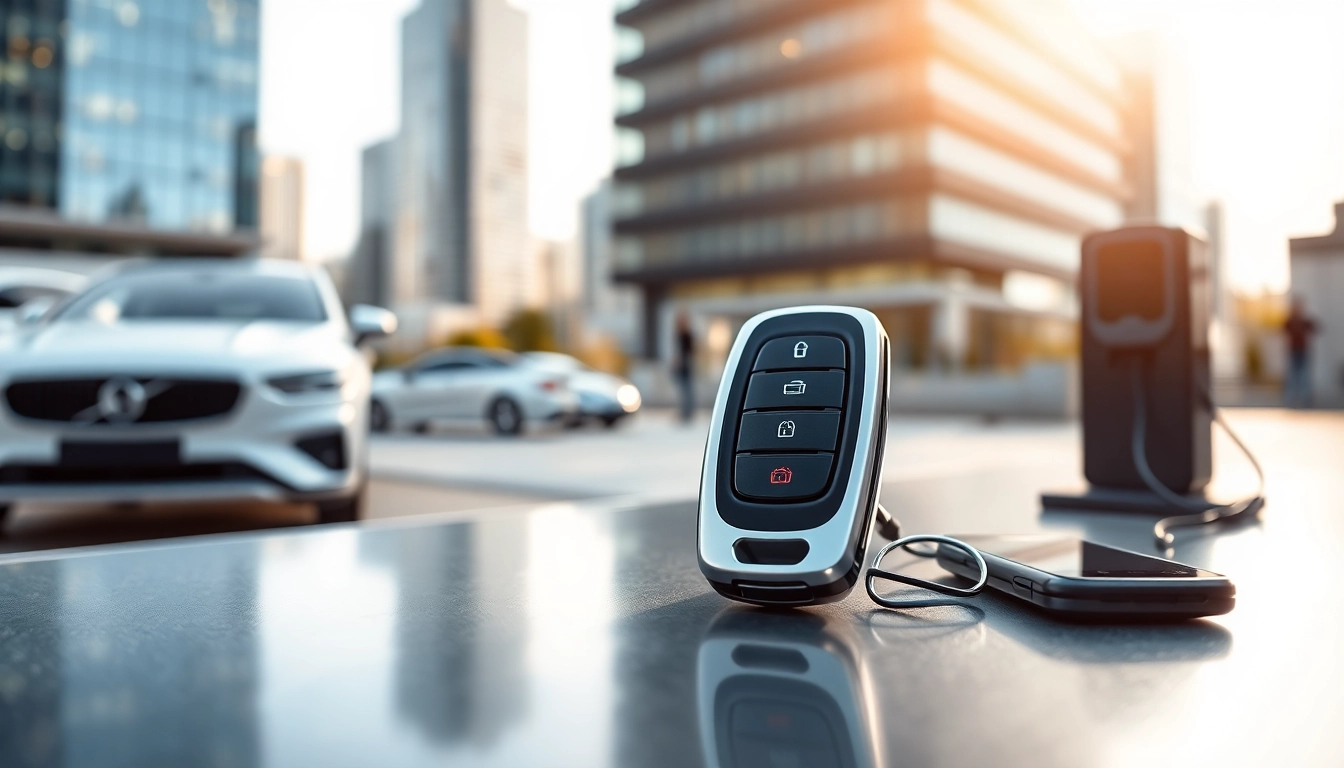Understanding Keys for Electric Cars
Introduction to Electric Car Keys
The transition to electric vehicles (EVs) hasn’t only transformed the way we drive, but it has also revolutionized the technology that facilitates vehicle access. In the realm of Keys for electric cars, the focus has shifted from traditional mechanical keys to advanced digital solutions that enhance convenience and security. As more consumers opt for electric cars, understanding these key systems is essential for both new buyers and seasoned EV enthusiasts.
Types of Keys for Electric Cars
Electric vehicles utilize various key technologies, which can be categorized primarily into three types: traditional keys, key fobs, and digital keys.
- Traditional Keys: Although most electric vehicles have steered away from mechanical keys, some low-end models still use them. These keys operate similarly to traditional cars, allowing access through a physical insertion and turning mechanism.
- Key Fobs: Key fobs have become the standard for most electric vehicles today. These small devices often include buttons for lock/unlock, trunk release, and panic functions. These fobs use radio frequency technology to communicate with the car’s receiver.
- Digital Keys: This is the latest evolution in vehicle access. Digital keys enable users to unlock and start their vehicles via smartphones or other digital devices, eliminating the need for physical keys. They use Near Field Communication (NFC) or Bluetooth technology for seamless interaction.
Benefits of Digital Keys
Digital keys come with a plethora of benefits. Their integration into the electric vehicle ecosystem streamlines the user experience, offering various advantages, including:
- Increased Convenience: Users can unlock and start their vehicles without searching for a key, making access almost instantaneous.
- Enhanced Security: Digital keys can include features such as biometric authentication and end-to-end encryption, making them significantly harder to duplicate or intercept.
- Customization: Users can often customize their key settings from within a mobile application, allowing them to control features such as unlocking doors or starting the engine from a distance.
How Keys for Electric Cars Work
Key Technology in Electric Vehicles
The technology behind keys for electric cars is continually evolving, fueled by advancements in both hardware and software. Key fobs and digital keys rely heavily on electronic components that facilitate wireless communication with the vehicle:
- Radio Frequency Identification (RFID): Many key fobs utilize RFID technology, which allows secure and fast communication between the key and the vehicle. Upon pressing a button or approaching the vehicle, the fob transmits a unique ID, granting access.
- Bluetooth Technology: Digital keys often use Bluetooth Low Energy (BLE) for interaction, which supports features like proximity-based unlocking. This innovative technology allows the vehicle to detect when the user is approaching.
- Mobile Applications: Many electric vehicles have designated smartphone applications that can be paired with the car. These apps not only manage key functionalities but also offer additional features like remote diagnostics and trip tracking.
Remote Access and Control Features
Modern electric vehicles equipped with digital keys are designed to provide users with enhanced control and remote access. These features often include:
- Remote Start: Users can start their vehicles from a distance using their smartphones or key fobs, great for pre-conditioning the cabin temperature during extreme weather.
- Location Tracking: Some systems allow users to track the vehicle’s location, which can be particularly useful in crowded parking scenarios.
- Control over Vehicle Functions: Users can often control features like lights, climate settings, and lock/unlock functions conveniently through a mobile interface.
Keyless Entry Systems
Keyless entry systems are becoming increasingly common in electric vehicles, allowing users to unlock their car without removing the key from their pocket or bag:
- Proximity Sensors: These sensors detect the key fob’s presence within a certain range, enabling the car to unlock automatically as the user approaches.
- Push-to-Start Technology: Once inside the vehicle, users can simply press a button to start the engine, eliminating the need for any physical insertion of the key.
- Customizable Access: Keyless systems can often be programmed to recognize multiple keys, allowing family members or friends limited access while maintaining security.
Choosing the Right Keys for Electric Cars
Factors to Consider When Selecting Keys
When purchasing an electric car, understanding the key options available is crucial. Here are key considerations:
- Do You Want Traditional or Digital? Preferences can vary, but identifying whether you prefer traditional, fob-based, or digital keys will influence your purchase.
- Compatibility: Ensure that you choose keys compatible with the specific make and model of your electric vehicle. Some vehicles have proprietary systems that limit key compatibility.
- Price and Value: Evaluate the pricing of different key options and consider the added conveniences and features that come with digital keys to determine their overall value.
Security Features
The security of your vehicle is paramount. When selecting keys for electric cars, buyers should consider the following security features:
- Encryption Standards: High-quality keys often employ advanced encryption methods to protect data transmission between the key and the vehicle.
- Two-Factor Authentication: Key functionalities that require user confirmation provide an extra layer of security, especially for digital keys.
- Tracking Capabilities: Some advanced key systems feature tracking capabilities that alert the owner if unauthorized access is attempted.
Compatibility with Different Models
Compatibility is critical when choosing keys for electric cars. Different manufacturers have different systems, and not all keys will work across all models. It’s essential to:
- Check Manufacturer Guidelines: Always refer to the manufacturer’s guidelines regarding key systems to ensure compatibility.
- Consider Aftermarket Options: Some aftermarket key solutions can provide better value, but they need careful consideration regarding compatibility.
- Review Consumer Testimonials: Research online for experiences from other users regarding specific keys and their compatibility with different electric car models.
Maintaining and Troubleshooting Keys for Electric Cars
Routine Maintenance Tips
Just like your vehicle, your keys require maintenance to ensure optimal performance. Here are effective maintenance tips:
- Battery Checks: For key fobs and digital keys, regularly check the battery life and replace batteries as necessary to avoid lockout situations.
- Physical Care: Clean your keys regularly to prevent dirt accumulation that may interfere with electronic components, particularly the buttons and connections.
- Software Updates: For digital keys, keep the associated smartphone application updated to benefit from the latest security features and functionalities.
Common Issues and Solutions
Despite the advanced technology in electric car keys, users may encounter issues. Here are common problems and their solutions:
- Key Not Responding: If your key fob is unresponsive, check the battery first; a weak battery is often the culprit.
- Access Problems: If your car doesn’t recognize your key, try reprogramming it according to the manufacturer’s instructions.
- Connection Issues: If your smartphone’s digital key doesn’t connect, ensure that Bluetooth is enabled and that your vehicle’s system is up-to-date.
When to Seek Professional Help
While many issues can be resolved independently, there are times when professional intervention is necessary:
- Broken Keys: If your key is physically damaged, a professional is needed for repair or replacement.
- Software Glitches: Persistent software issues may require expert diagnosis and troubleshooting beyond the average user’s capabilities.
- Key Reprogramming: If you need to reprogram your keys for security purposes, seeking professional assistance is often the most reliable approach.
The Future of Keys for Electric Cars
Trends in Electric Car Technology
The future of keys for electric cars is tied closely to emerging technologies in the automotive sector:
- Increased Use of Biometrics: Future keys may integrate biometric technology to offer additional layers of security, such as fingerprint or facial recognition systems.
- Integration with Smart Home Technologies: Keys may increasingly integrate with smart home systems, allowing users to manage their vehicle and home security systems from a single application.
- Enhanced Vehicle-to-Everything (V2X) Communication: As vehicles become more interconnected, keys will evolve to facilitate communication with nearby infrastructure for improved security and convenience.
Consumer Expectations for Key Features
As technology progresses, consumer expectations will also evolve. Key features that consumers are likely to demand include:
- Seamless Integration: Customers want unification between key functionalities and vehicle performance systems.
- User-Friendly Interfaces: The demand for key management via intuitive smartphone applications will continue to grow.
- Robust Security Protocols: As cyber threats increase, consumers will expect advanced security measures to protect their vehicles from unauthorized access.
Predictions for Key Developments
Looking ahead, we can predict several key developments that will shape the future of vehicle access:
- Rise of Contactless Technology: The trend towards contactless technology will continue, minimizing physical contact with keys to improve user convenience and hygiene.
- Advanced AI Integration: AI could improve the adaptability of key systems, enabling them to learn user behaviors and automatically adjust settings accordingly.
- Legal and Regulatory Changes: As key technologies evolve, regulatory changes may arise, influencing standards for security, accessibility, and technology implementation across the automotive industry.



